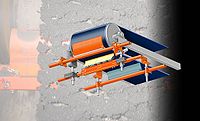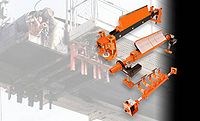Difference between revisions of "Belt Scrapers"
| Line 42: | Line 42: | ||
==Function, Cleaning and Care== | ==Function, Cleaning and Care== | ||
*Primary Belt Cleaners:The function of the primary cleaner is to "scalp" the belt of the coarse carry back materials which would otherwise overload the secondary and tertiary cleaners. In terms of volume, the primary cleaner is responsible for the removal of up to 75% of the total carry back and is an essential part of the system. It has the added advantage of placing the carry back directly into the flow of material. The course materials do not cause a problem of carry back. This is normally because of the fine and sticky particles in the mix of material. These fine and sticky particles are removed by the secondary and [[Tertiary Cleaners]]. | *Primary Belt Cleaners:The function of the primary cleaner is to "scalp" the belt of the coarse carry back materials which would otherwise overload the secondary and tertiary cleaners. In terms of volume, the primary cleaner is responsible for the removal of up to 75% of the total carry back and is an essential part of the system. It has the added advantage of placing the carry back directly into the flow of material. The course materials do not cause a problem of carry back. This is normally because of the fine and sticky particles in the mix of material. These fine and sticky particles are removed by the secondary and [[Tertiary Belt Cleaners]]. | ||
*Secondary Belt Cleaners: The function of the secondary cleaner is to remove fine and sticky materials from the belt after the primary cleaner has removed the course carry back. In terms of volume removed, the secondary cleaner does not appear to be as effective as the primary cleaner. However, this does not ring true when looking at the mess around a conveyor or the build-up on return rollers. It is the fine and sticky material that is responsible for the mess as it is particularly hard to remove. In many cases, it is necessary to apply water to the belt in front of the secondary cleaner to achieve the required result. | *Secondary Belt Cleaners: The function of the secondary cleaner is to remove fine and sticky materials from the belt after the primary cleaner has removed the course carry back. In terms of volume removed, the secondary cleaner does not appear to be as effective as the primary cleaner. However, this does not ring true when looking at the mess around a conveyor or the build-up on return rollers. It is the fine and sticky material that is responsible for the mess as it is particularly hard to remove. In many cases, it is necessary to apply water to the belt in front of the secondary cleaner to achieve the required result. | ||
Latest revision as of 01:02, 18 February 2013
Belt Scrapers or Belt Cleaners are used to clean Conveyor Belts. Belt Scrapers are exceptionally simple in design, its operations can certainly save thousands of man-hours, reduce injury hazard and prevent downtime from damaged components. These are used in bulk material handling belt conveyors to avoid material carry back and reduce spillage. Clean belts help prevent material build-up on snub pulley & return idlers, thereby reducing maintenance and downtime.
Operation and Performance
The function of an efficient belt cleaning system is to remove the fugitive material which remains on the return strand of the belt and to assist in spillage control by returning that material to the main material flow within the confines of the discharge chute.
Types of Belt Scrapers
Primary Belt Cleaners or Precleaners
Primary Belt Cleaners or Precleaners are an essential part of any conveyor system. Belt cleaners help remove bulk material product carry back and prevent it from falling off at various points of the conveyor along the return side of the belt causing various housekeeping and conveyor belt maintenance problems. These are installed at a positive angle, these primary belt cleaners would be mounted directly against the head pulley below the normal trajectory path of the material.
- Mounted on the head pulley.
- Mounted below the material flow.
- Blade is always narrower than the belt width.
- Ideally, the blade covers just the belt’s material path. Removes the big stuff.
- Typically cleans off up to 80% of the initial carryback.
Carry back of Primary belt cleaners can lead to:
- Excessive buildup and wear on conveyor belt idlers and pulleys.
- Conveyor belt misalignment due to the artificial crown created by the carry back.
- Accumulation of material falling off conveyor belt idlers and structure to the ground or on buildings, vehicles or even people.
- Negative and unsafe work environment.
Secondary Belt Cleaners
Secondary Belt Cleaners move bulk material product build-up and prevent it from falling off at different points of the conveyor. Points along the return side of the belt can cause various conveyor belt maintenance problems due to carry-back. Installed after the point where the belt leaves the head (discharge) pulley and or anywhere on the return side of the belt where it can be cleaned and maintained effectively.
- Special secondaries may allow for mounting under the head pulley.
- Blade width is always the belt width or wider.
- Removes sticky fines - the final cleaning job.
- Cleaning efficiencies can be 90% +.
- May require a hold-down roller for maximum performance.
Carry back of Secondary Belt Cleaners can lead to:
- Excessive buildup and wear on conveyor belt idlers and pulleys.
- Conveyor belt misalignment due to the artificial crown created on the conveyor belt by material carry-back.
- Accumulation of material falling off idlers and structure to the ground or on buildings, vehicles or even people.
- Negative and unsafe work environment.
Function, Cleaning and Care
- Primary Belt Cleaners:The function of the primary cleaner is to "scalp" the belt of the coarse carry back materials which would otherwise overload the secondary and tertiary cleaners. In terms of volume, the primary cleaner is responsible for the removal of up to 75% of the total carry back and is an essential part of the system. It has the added advantage of placing the carry back directly into the flow of material. The course materials do not cause a problem of carry back. This is normally because of the fine and sticky particles in the mix of material. These fine and sticky particles are removed by the secondary and Tertiary Belt Cleaners.
- Secondary Belt Cleaners: The function of the secondary cleaner is to remove fine and sticky materials from the belt after the primary cleaner has removed the course carry back. In terms of volume removed, the secondary cleaner does not appear to be as effective as the primary cleaner. However, this does not ring true when looking at the mess around a conveyor or the build-up on return rollers. It is the fine and sticky material that is responsible for the mess as it is particularly hard to remove. In many cases, it is necessary to apply water to the belt in front of the secondary cleaner to achieve the required result.
The efficiency of any belt cleaning system will be affected by the following factors:
- Correct specification of belt cleaners
- Use of water and proper regulation
- Belt specification, condition and type of join
- Correct installation Belt stabilization
- Belt tension Regular inspection and maintenance programmes
Return Belt Ploughs
Ploughs are designed to clean the inside of a conveyor belt on its return trip and to remove any large lumps that can potentially damage the belt or tail pulley lagging if allowed to travel through this area. Installation: It is important that the ABS Plough be correctly positioned, ideally on a flat surface as close as practicable to the tail end or take-up area of the conveyor. The apex of the plough should be located 150 mm behind a flat return roller to achieve optimum cleaning performance.
- Loosely assemble plough connecting linkage arms to the plough body.
- Place the plough on the belt and ensure there is enough clearance. Position the mounting brackets in either a vertical or horizontal position, ensuring the centre line of the pole is between 190-350 mm above the return side of the belt.
- Mark and drill the holes to correspond with the mounting brackets and attach with M12 bolts.
- Centralize the ABS Plough in the correct position to the belt, located by locking shaft collars into position.
- Adjust the turnbuckle so the plough sits evenly across the belt.
- Test run belt to ensure the correct operation of the unit.
Impact beds
Extending belt life, reducing wear on Idlers and reducing downtime is achieved by using impact beds, which support the conveyor belt and cushion it against the shock impact of heavy loads. ABS custom-makes and supplies impact beds and skirting for all high impact areas on transfer chutes to suit any site application.
Video

